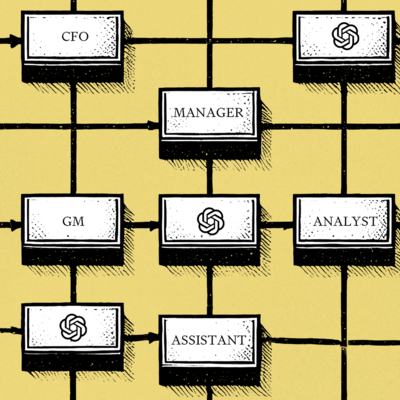
The Once and Future History of Knowledge Work
Technology brought knowledge work into this world. Can AI take it out?
November 22, 2024
Artificial intelligence is changing the value of knowledge work—something that Katie Parrott, as a knowledge worker herself, has been grappling with. So it’s a fitting topic of exploration for the debut piece of her column, Working Overtime, in which she’ll examine the historical impact of technology through the lens of workers and the systems they participate in. (Longtime Every readers may recognize her byline from when she served as our managing editor.) Knowledge work is a term, Katie writes, that’s long made her somewhat uncomfortable because of its elitist connotations. But the rise of AI offers an opportunity to reevaluate both the lingo and the role that so-called knowledge workers play in society and the economy.—Kate Lee
Was this newsletter forwarded to you? Sign up to get it in your inbox.
In 1999, management consultant Peter Drucker made a prediction that was either prophecy or hubris: Knowledge workers, he wrote in California Management Review, would be “the most valuable asset of a 21st-century institution.” A quarter of the way through the century, however, the future of knowledge work has never been more uncertain—thanks in no small part to generative AI.
The term “knowledge work” has always made me uneasy. Coining the term in 1959, Drucker defined it as “high-level” professionals who use their theoretical and analytical expertise, often gained through formal education, to create products and services. I couldn’t begin to tell you how to wire a house or repair a car. Those jobs require immense skill and vast knowledge, yet they are rarely classified as “knowledge work.” This corporate lingo carries more than a tinge of classism, social hierarchy, and condescension—as if real work happens only in front of a computer screen, pushing pixels around and complaining about the hardship of having one’s camera on during Zoom calls.
That said, as a marketer, I very much fit Drucker’s definition of a knowledge worker, regardless of how that makes me feel. And as someone who would like to pay her bills for the next 50-plus years, I have a vested interest in understanding how AI will affect knowledge work—and thus, my career.
Perhaps it wouldn’t be such a bad thing if knowledge work were to see a shakeup in the wake of AI. After all, it’s become a little big for its own britches over the past couple of decades, dominating our collective understanding of what makes a “good job.” Maybe knowledge work deserves to be taken down a few notches.
With the proliferation of new models capable of doing everything from writing code to creating images to completing legal documents, we’re approaching an inflection point in the evolution of knowledge work. So it’s worth taking stock, both of the road that got us here and the roads we could go down next. Think of this essay as a visit from the ghosts of knowledge work past, present, and future, and then ask: What might the future hold for knowledge work—and what kind of work do we want to shape the rest of the 21st century?
Sponsored by: Every
Tools for a new generation of builders
When you write a lot about AI like we do, it’s hard not to see opportunities. We build tools for our team to become faster and better. When they work well, we bring them to our readers, too. We have a hunch: If you like reading Every, you’ll like what we’ve made.
The past: A brief history of knowledge work
Drucker may have coined “knowledge work,” but the concept didn’t spring forth from his brain fully formed and ready to complete Jira tasks. The term may only go back a few decades, but people have been doing knowledge work for millennia. Oral storytellers, monks inking manuscripts, gentlemen scientists writing treatises on the origin of species and other such ideas—all of these represent prototypical forms of what today we recognize as knowledge work.
The fate of knowledge work and technology have long gone hand in hand. If we’re tracing knowledge work’s modern iteration, the starting point is the Industrial Revolution. The introduction of factories, complex machines, and assembly lines meant that fewer people were needed to do manual labor, and in their place arose a need for management strategies and administrative and clerical work. By the time Drucker, a longtime New York University professor and winner of the Presidential Medal of Freedom, came up with the term “knowledge work” in the late 1950s, mainframe computers had already arrived, with their ability to crunch data at many, many multiples the speed of human data analysts.
And then came the personal computer in 1974. And Microsoft Excel in 1987. And public access to the World Wide Web in 1991. Each subsequent technological innovation accelerated the rate at which work could get done and, yes, rendered some occupations obsolete or less prevalent. But it also brought with it new forms of knowledge work and new knowledge workers with specialized skills to do that work. Computer programmers, information technology and cybersecurity professionals, web designers, digital marketers—all were created in response to modern technology.
As knowledge work has grown, so has its status. Economists talk about the “skill premium”—the difference in pay between “high-skill” workers with advanced education, training, or expertise, and “low-skill” workers with fewer qualifications or specialized skills. For decades, the skill premium has increased—even as the number of knowledge workers has grown, as economist Daniel Susskind wrote in his 2020 book A World Without Work. More than 60 percent of U.S. workers are classified as “white collar” as of 2023, yet these jobs continue to command higher wages than most “low-skilled,” “blue-collar” jobs. This flies in the face of conventional wisdom about supply and demand, which tells us that a product, even labor, grows less valuable the more supply exists.
The forces of technological change have not been as kind to other segments of the economy. The past few decades have seen a “hollowing out” of the middle class—a sort of unequal barbell effect that, yes, has pushed some earners into the economy’s penthouse, but has pushed far more into the basement.
There are factors at play here besides technology—most significantly, the offshoring of manufacturing and the U.S.’s subsequent transition into a predominantly service-based economy. But even there, technology has played a starring role, facilitating communication and productivity even when teams are oceans apart. And so the pattern stands: When new technology is introduced, knowledge work benefits while other forms of labor take a hit. The question then becomes: Will generative AI continue this pattern, or break it?
The present: The rise of the robots
In the decades between the Industrial Revolution and the AI revolution, it seemed like knowledge work was marked safe from the rise of automation. When management consultants and economists stressed the threat to “routine tasks,” it called to mind cashiers and assembly line workers, not lawyers, graphic designers, and—yes—management consultants. After all, how could you automate the complex, cognitive tasks that defined office life—things like writing reports, analyzing data, crafting strategies, or managing teams, right? Right?
Well, the joke’s on us. As it turns out, machines can do all of those things better, faster, or at the very least cheaper than humans can. The Pew Research Center, the Brookings Institution, and McKinsey and Company all forecast that the workers most likely to see “exposure” to generative AI are more educated and in higher-paid fields such as computer science, business and finance, legal, and management.
This shift has ushered in what Every’s Dan Shipper calls an allocation economy, where the value of work increasingly hinges not on traditional labor but on how we allocate scarce resources—time, attention, and focus. In this new paradigm, the question becomes less about what AI can do and more about how we choose to use it, what we allow it to replace, and what we choose to preserve as uniquely human.
Technology has historically had two countervailing effects on labor—what economists call the “substituting force,” which replaces labor, and the “complementary force,” which augments it. Generative AI optimists argue the complementary force has won out through each subsequent wave of technology. A classic example is the ATM, which should have replaced bankers but correlated with an increase in bankers instead as those bankers, freed from the tedium of counting out bills, put their financial knowledge to work developing new products and services for bank customers to take advantage of. Generative AI will be no different, proponents claim. It will give knowledge workers “superpowers,” automating away the boring, tedious aspects of knowledge work and leaving more time for high-level, creative, and emotional tasks—the kind of tasks, the thinking goes, that only humans can perform.
However, not everyone who studies AI’s impact is so bullish. With generative AI poised to automate an increasing number of business activities—as much as 70 percent , according to McKinsey—critics worry there simply won’t be enough work left over for most workers to do. For the first time in history, the argument goes, technology’s substituting force will overwhelm the complementary force. Already, Susskind writes, the most valuable company in the world, Apple, employs about 20 percent as many people (160,000) as the most valuable company of 50 years ago, AT&T (750,000). If this shrinking trend continues, and with the possibility of one-person billion-dollar companies on the horizon, there may just not be enough work to go around—even for knowledge workers.
While much of the discourse around AI’s impact tends to polarize around “more jobs” or “fewer jobs,” there is a third alternative: different jobs. Some economists predict that, unlike industrial automation, AI will reduce the skill premium, acting as a corrective force on the disparity between wages for “skilled” and “unskilled” labor. They argue that generative AI can help restore “middle-skill, middle-class” jobs to the U.S. market that were displaced by industrial automation and globalization. And then the question becomes: If knowledge work no longer commands a wage premium—if new pathways open up that lead to economic security and even prosperity—who will still choose knowledge work, and who will choose something else?
The future: How will AI change knowledge work?
Now comes the part where we peer down the possible roads that generative AI could lead us. The blueprints for each of these roads are in our hands—we have the materials to build them at the ready. So which one will we build?
Option 1: The optimistic scenario
Technology continues to do what it has done for more than a century: create new jobs. Meanwhile, AI lowers the barrier to entry, more people can become knowledge workers, and knowledge work itself becomes democratized. The economic pie grows and everyone gets a bigger slice. As more people join the ranks, the exclusive luster of knowledge work dims—but that’s a good thing. The deglamorization of knowledge work levels the playing field between it and other forms of labor, and professions that have historically been devalued and marginalized—such as care work and service work—assume their place among the things “humans do best.”
Option 2: The dystopian scenario
AI doesn’t just replace some of us—it displaces a lot of us. The hollowing of the labor market not only continues but accelerates, with a small class of elite knowledge workers holding on to the complex, creative jobs that AI can’t quite manage, while everyone else finds themselves funneled into lower-paying, less secure roles. Knowledge work becomes hyper-specialized, a luxury job for the few, and its aura of prestige and exclusivity ossifies into a silicon ceiling that is impossible for most of the population to crack.
Option 3: The utopian scenario
With AI doing the grunt work, we’re free to pursue our passions. Knowledge work and the cult of productivity lose their centrality to our identities, and instead, we engage in creative endeavors, pursue hobbies, and take on entrepreneurial projects—not because we have to, but because we want to. It’s the dream of a post-scarcity economy: Work becomes optional, and we’re left with the freedom to explore what matters most to us.
Freeing the future of work
The future of knowledge work may be uncertain, but we have a say in how AI reshapes our lives and livelihoods. It’s easy to feel dwarfed by the pace of technological change, to imagine that the future of work is something that happens to us, rather than something we have the power to shape.
But this perspective gives us too little credit. We have agency, as workers, voters, and participants in the economy, to advocate for frameworks that guide AI’s influence in directions that support human dignity, opportunity, and equality. Instead of letting the sheer efficiency and velocity of technology dictate our path, we can demand social and economic norms that center people alongside profit.
This will require a collective will to prioritize humanity over efficiency, and depth over speed. It means questioning the motives behind AI deployment—who benefits, who loses, and who decides. It means writing legislation, regulations, and industry policies that protect meaningful work for all and exploring new forms of social and economic support for those affected by this shift.
The future of knowledge work is not a foregone conclusion. It’s a construction site where we have the chance to lay down each brick with intention. It's also an opening, a chance to imagine a world where work doesn’t define us, where we have space to pursue what we love, regardless of whether what we love comes with a desk or a degree attached. That world isn’t guaranteed, but it’s there if we’re willing to build it—brick by brick, pixel by pixel, person by person.
Katie Parrott is a writer, editor, and content marketer focused on the intersection of technology, work, and culture. You can read more of her work in her newsletter.
To read more essays like this, subscribe to Every, and follow us on X at @every and on LinkedIn.
We also build AI tools for readers like you. Automate repeat writing with Spiral. Organize files automatically with Sparkle. Write something great with Lex.
Find Out What
Comes Next in Tech.
Start your free trial.
New ideas to help you build the future—in your inbox, every day. Trusted by over 75,000 readers.
SubscribeAlready have an account? Sign in
What's included?
-
Unlimited access to our daily essays by Dan Shipper, Evan Armstrong, and a roster of the best tech writers on the internet
-
Full access to an archive of hundreds of in-depth articles
-
-
Priority access and subscriber-only discounts to courses, events, and more
-
Ad-free experience
-
Access to our Discord community




Comments
Don't have an account? Sign up!